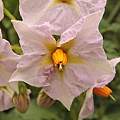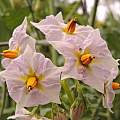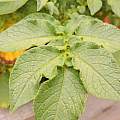The genus Solanum is perhaps most famous for the agricultural crops (tomatoes, potatoes, etc.) but contains many ornamental and even some geophytic species. The genus contains roughly 1,500-2,000 species of annuals, perennials, vines, shrubs and small trees from Australia, North and South America, and much of Europe. Many are toxic or have toxic parts.
Solanum tuberosum, otherwise known as the ubiquitous potato, is a tuberous food crop mostly from South America with the center of diversity in the Andes. Genetic tests have confirmed the origin of the potato to be in Southern Peru. Thousands of cultivars are grown for their variously shaped, colored, and flavored tubers which really need no introduction. They are perennials, and are grown easily in average garden soil. Some selections will form countless tiny pea-sized tubers along with the main crop that can either be left in the ground or replanted elsewhere to form full sized potatoes in subsequent years. When they are happy they will flower, and they are quite pretty.
Typical of solanoid flowers, the anthers are poricidal (in a way very similar to the flowers of Dodecatheon and require sonication (buzz-pollination) to be functionally pollinated, typically by bumblebees or other large bees capable of sonication.


